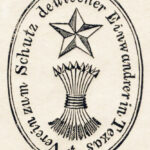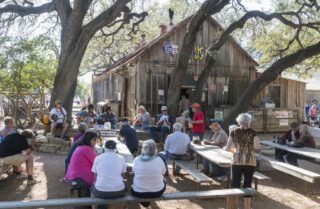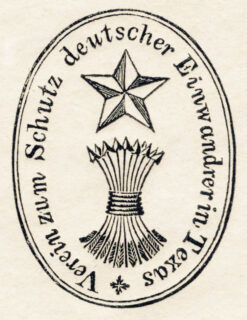Texas Germans’ Migration and Knowledge
A Miniseries on Nineteenth-Century Germans’ Migration to Texas and Knowledge Transfers
With contributions by Jana Weiss, Abigail Escobedo and Simon Herbert, Jacob Johnson and Taylor Mullins, Rodolfo Alvarez and Aubrey Hernandez, Aiden Maliskas and Mark McShaneIntroduction
In 1847, John O. Meusebach was seeking to set up a peace treaty with the Native American tribe, the Penateka Comanches. Meusebach’s negotiation of a peace treaty with them was crucial to the success of the German settlement project in Texas, spearheaded by the Mainzer Adelsverein for which Meusebach served as a commissioner-general. Ultimately, the treaty sought to ensure the settlers’ safety and regulated trade relations between the two parties.1 However, entering Comanche territory was risky as one could not foresee how the Comanches would react to settlers crossing into their territory. Hence, Meusebach’s knowledge of and diplomatic skills with the Comanches were critical. He gained these from three sources, in particular: Meusebach’s predecessor as commissioner-general, Prince Carl of Solms-Braunfels, the colonial director of Fredericksburg, Friedrich Armand Strubberg, and noted geologist Ferdinand Roemer, who was part of the expedition into native territory in early January 1847; all provided oral and written reports that contributed to Meusebach’s knowledge of these Native Americans.
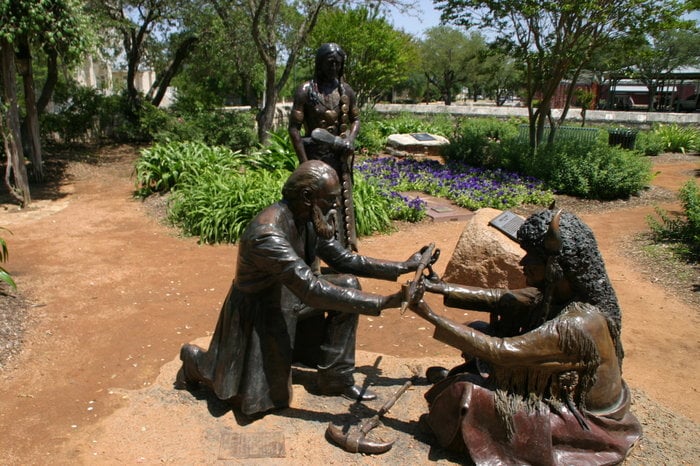
This blogpost examines and compares these three sources: First, the reports Prince Carl wrote back to the Mainzer Adelsverein give insight into his knowledge about the Comanches; second, Strubberg’s novel Friedrichsburg recounts his own experiences while visiting Texas, including his interactions with the Comanches; third, Roemer’s travelog Texas provides a detailed account of his two-year sojourn on the Texan frontier between 1845 and 1847. Roemer’s chapter on his experiences during Meusebach’s expedition into Comanche territory is particularly important for our purposes.2
We will then compare all three to Meusebach’s own 1893 testimony in front of the District Court of McCullough County, Texas, in which he described his relations to and knowledge of the Comanches before making a treaty. Unfortunately, such written pieces by Meusebach are rare. His testimony details his experiences managing the land grant and trying to achieve and maintain peace with the Comanches.
While no scholarly work examines Meusebach’s knowledge about the Comanches, in particular, some scholars have assessed early German-Indigenous relations on the Texan frontier. For example, in his introduction to his annotated translation of Strubberg’s novel Friedrichsburg, James C. Kearney presents an overview of Strubberg’s life story and critically evaluates the accuracy of the novel.3 Moreover, Matthew Babcock outlines the course of the Meusebach-Comanche treaty in detail and examines how Meusebach’s leadership skills helped to succeed in this.4
Comanches and a German Prince
Long before the 1830s, when the first German settlers arrived in Texas, the Comanches roamed across most of the Southern Plains. They first appeared in a Spanish record in 1706 and soon had more recorded interactions with other settlers. Yet, knowledge of them was not widespread when the Germans first encountered them.5
The Mainzer Adelsverein, founded in 1842 by German noblemen, sought to establish settlements in Texas and organize German emigration. Ultimately, the Fisher-Miller land grant served as the basis for this undertaking – even though no member of the Adelsverein had actually examined the land itself. In the end, this land turned out to be inadequate for settlement as it was already settled by several (potentially hostile) Native American tribes and was unsuitable for agriculture due to infertile soil.6
Prince Carl of Solms-Braunfels was the first commissioner-general of the Mainzer Adelsverein in Texas. In his position, he was in charge of protecting the German settlements and organizing safe passage for migrants from their port of arrival to the settlements.7 Well aware that a part of the grant was Comanche territory, Prince Carl sent reports back to the Adelsverein in Germany, repeatedly mentioning the Comanches and stressing their significance to the settlement project. For instance, in his third report from August 26, 1844, Prince Carl described the Comanches as “great in number and brave,” emphasizing the two threats he saw in them: they outnumbered the Germans and were willing to fight back. Noting the treaty he sought to establish with the Comanches, he maintained that, if they did not agree to his terms, he would “immediately strike them such a blow that they will be rendered harmless for a long time to come, if not forever.” Thus, he clearly presented the Germans as superior. However, knowing that the Comanches were numerous and good warriors, Prince Carl asked the Adelsverein to provide weapons and men for defense against possible attacks. He also stated that he would not approach the Comanches before the Adelsverein delivered sufficient military resources.8
In sum, the reports provide insight into Prince Carl’s knowledge of the Comanches, highlighting them as a serious threat. Furthermore, they show that he believed sufficient armament was absolutely necessary since there was a chance they would fight and not comply with a treaty. Nevertheless, Prince Carl’s knowledge of the Comanches seemed very limited. He gave neither detailed information about them, nor did he report any personal encounters. He only conveyed they were a possible threat to the German settlement project. It is plausible that Prince Carl’s military background influenced his harsh choice of words and planned brutality if they resisted.9
Meusebach Takes Over as Commissioner-General
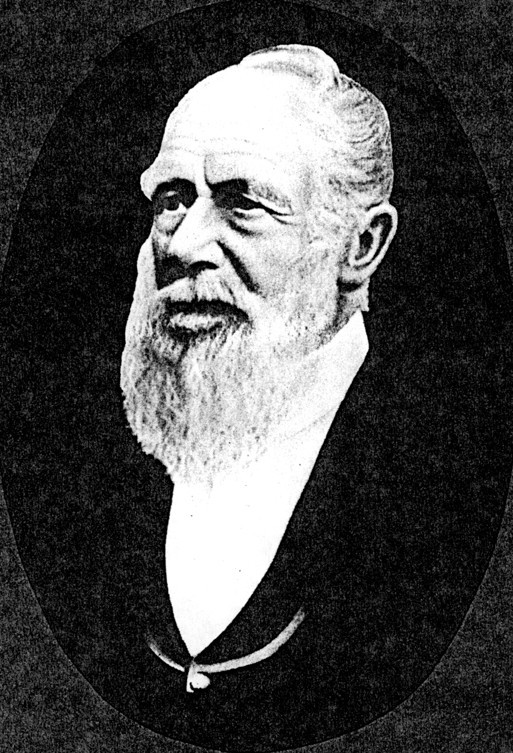
Appointed commissioner-general on February 24, 1845, Meusebach then arrived in Galveston, Texas, in April.10 Prince Carl wrote his first report on July 15, 1844, and his last report on April 30, 1845. In his testimony, Meusebach mentioned knowing Prince Carl’s reports. Hence, it is likely Meusebach read these reports to prepare taking over his position as commissioner-general. Therefore, Prince Carl’s reports presumably shaped Meusebach’s knowledge of the Comanches. Prince Carl also met with Meusebach in Galveston and exchanged information concerning the state of the settlement project. Although there is no direct reference proving that Meusebach and Prince Carl specifically talked about the Comanches, the direct contact makes it highly likely that a transfer of knowledge took place.
Meusebach sought to establish a safe colony for German immigrants. A year prior, Meusebach had appointed fellow German émigré Friedrich Armond Strubberg to lead the colonists to Fredericksburg on the advice of Henry Francis Fischer, one of the aforementioned land grant initiators. Eventually, Meusebach and Strubberg quarreled because of Strubberg’s management, which included the development of churches, use of supplies, and communal fields. After Strubberg instigated a failed coup d’etat against Meusebach, he was dismissed as colonial director.11 Nevertheless, Strubberg likely passed on his knowledge of the Comanches to Meusebach through their numerous interactions.
In Meusebach’s 1893 testimony, he reflected on his work for the Mainzer Adelsverein. Since Meusebach reported all events in a chronological order, his answers give insights in his knowledge of the Comanches before and after he had entered their territory. It is remarkable that he called them “hostile Indians” four times before he described making a treaty with them. “At full moon we made a treaty with the head chiefs Buffalo Hump, Santa Anna and Mopechucope, and their people, for all the western bands of Comanches.” After personally meeting Comanche leaders, he called them by name and no longer referred to them as “hostile Indians” but as “people” and “Comanches.” Thus, Meusebach’s choice of words reveals how his perception of the Comanches was changed by his contact with them. Accordingly, it is likely that Prince Carl’s reports depicting the Comanches as a dangerous threat had influenced him previously when he referred to the land as being “in the undisturbed possession of hostile Indians” and stated that it “had to be conquered by force or by treaty.”12
Overall, Meusebach’s descriptions of the Comanches were very similar to Prince Carl’s reports on them. Meusebach knew that German settlements in Texas could not exist without a treaty. He approached the Comanches accompanied by military support as Prince Carl had suggested. However, when meeting with the Comanches, he agreed to have the men “discharge their rifles as a sign of good faith.”13 In turn, this shows that Meusebach’s knowledge had extended beyond Prince Carl’s reports since he decided to dispense with military means to force compliance. Meusebach managed to strike the deal by solidifying Comanches’ trust in the Germans. He, for instance, invited a Comanche group passing by the Germans’ camp to join them for dinner although they were low on food. Furthermore, Meusebach tolerated Comanches’ rustling the Germans’ horses and did not retaliate.14 According to Roemer, the Germans felt welcomed. However, while Roemer was struck by the hospitality of “our Indian friends,” he also reflected on how the Comanches used their power over the comparatively small group of German settlers (approximately 6,000 Comanches greeting a group of 40): “we discovered throughout the course of our visit, that their hospitality was more of a negative kind, consisting mainly in the assurance that we would be protected against murder and robbery during our stay, occasional thefts of small articles of course expected.”15 This emphasizes the Comanches’ desire to gain something from the arrangement, which Meusebach acknowledged early on by offering gifts during their initial meeting and by designing a treaty that also benefited the Comanches. According to Meusebach, he intended for the treaty solely to facilitate economic prosperity, which would follow once surveyors came. In his testimony, he stated that he “promised [the Comanches][; $3,000 worth of presents, for which consideration they on their part promised and agreed not to disturb our surveyors in their work, nor to do any harm to our colonists.”16
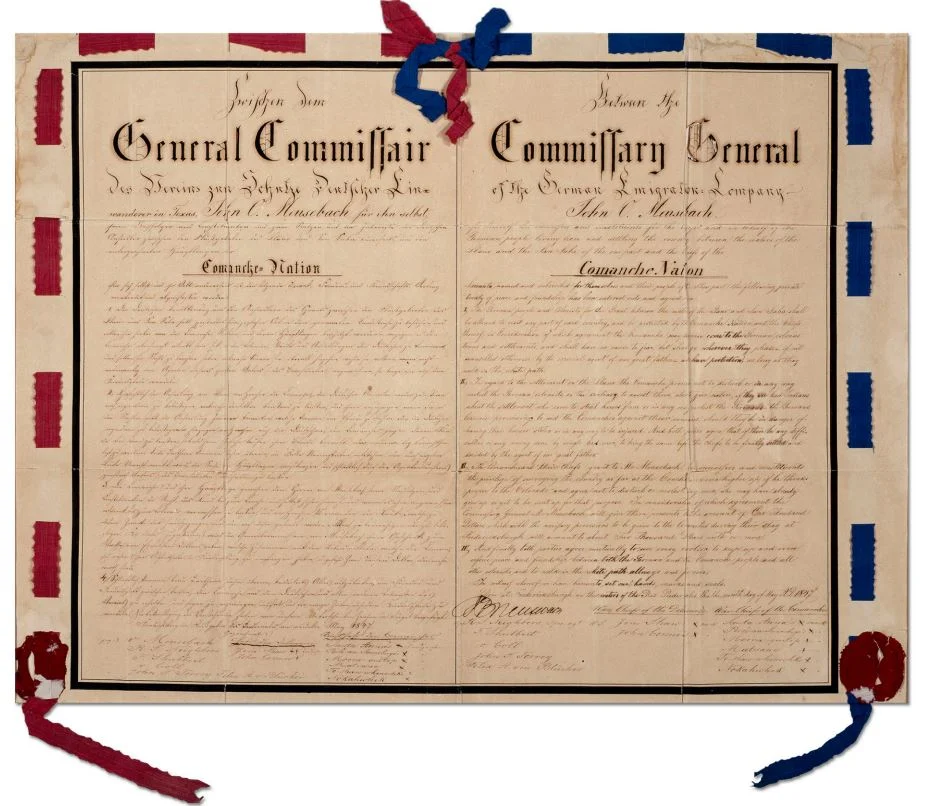
Interestingly, in his 1867 novel, Strubberg provided his version of Meusebach’s poor leadership qualities and the treaty of 1847, as well as detailing the tribes’ characteristics. Despite calling the Native Americans “savages” and “wild ones,” Strubberg acknowledged their skills and described them as very knowledgeable about the area. Most importantly, he probably had passed on some knowledge to Meusebach as he had himself led an armed group of colonists into Comanche territory. It is an open question how much his (probably exaggerated) estimation of native “warriors” traveled and held true.
Regardless, one can infer that Meusebach knew the Comanches’ strength and inapproachability. As Strubberg stated in his novel, the Comanches were “the most warlike of the Texas Indians.”17 Strubberg’s assessment only added to the precautions Meusebach and his men had to take. One can surmise that the Comanches were self-protective because of past failed treaties. The outside world may have perceived this as intimidating, much as Prince Carl spoke about their power in his reports to the Adelsverein. Yet, by the time Germans arrived in Indigenous territory, the Comanches had already suffered greatly from countless attacks by Anglo-Texan troops. Trade opportunities and a desire for peace seem to have influenced both sides in this interethnic cooperation.18 Money and caution proved crucial to making this cooperation last.
Conclusion
In conclusion, Prince Carl of Solms-Braunfels, Ferdinand Roemer, and Friedrich Armand Strubberg played a central role in shaping Meusebach’s knowledge of the Comanches before and during his expedition into Native American-controlled territory. Although some of the sources were published after the treaty, they give insight into the knowledge that was around at that time. Meusebach seemed highly knowledgeable about Comanche principles and reflective about his complex relations with Prince Carl and Strubberg. While his relations with some fellow émigrés were not always friendly, he nonetheless relied on them for information to make this treaty work. Meusebach had a strong reputation for keeping his word, and, to this day, the Meusebach-Comanche Treaty of 1847 is the only treaty signed with the Comanches that settlers did not break.19

Abigail Amalia Escobedo is an undergraduate student in Exercise Science at the University of Texas at Austin. She also has an interest in history.

Simon Herbert is a transfer student from the University of Würzburg, Germany, studying American Studies at the University of Texas at Austin. He is interested in how German immigrants shaped and contributed to U.S. history and culture.
- Mathew Babcock, “German-Comanche Diplomacy on the Texas Frontier: Assessing the Meusebach-Comanche Treaty of 1847,” Yearbook of German-American Studies 56 (2021): 57–72, 64. ↩︎
- See Chester William and Ethel H. Geue, A New Land Beckoned: German Immigration to Texas 1844–1847 (Baltimore, 1966); Friedrich Armand Strubberg, Friedrichsburg: A Novel, transl. and annot. James C. Kearney (Austin, 2012 [German orig., 1867]). Ferdinand Roemer, Texas: With Particular Reference to German Immigration and the Physical Appearance of the Country, transl. Oswald Mueller (Austin, 1995 [1849]), esp. 265–73. Born in Hildesheim, Germany, Roemer was sent to Texas in December 1845 by the Berlin Academy of Science. As a geologist, he primarily examined the geology of Texas, particularly the area of the Adelsverein’s land grant. However, Roemer was also interested in the Comanches. The preface to the 1983 edition of his work Texas praises it as exceptionally “accurate” (i). His detailed insights into German-Comanche relations constitute a valuable resource for research in this field. ↩︎
- Kearney in Strubberg, Friedrichsburg. ↩︎
- Babcock, “German-Comanche Diplomacy.” ↩︎
- Daniel J. Gelo and Christopher J. Wickham, Comanches and Germans on the Texas Frontier: The Ethnology of Heinrich Berghaus (College Station, 2018), 23–24. Gelo and Wickham note that the Comanches did not survive long in the land after settlers arrived. ↩︎
- Kearney in Strubberg, Friedrichsburg, 6–7. NB: The assessment that the soil was infertile proved to be wrong. ↩︎
- Rudolph L. Biesele, “The Relations between the German Settlers and the Indians in Texas, 1844–1860,” Southwestern Historical Quarterly 31, no. 2 (1927): 116–29, 116, 119. ↩︎
- All quotes cit. in William and Geue, New Land, 36. ↩︎
- Theodore Gish, “Carl, Prince of Solms-Braunfels, First Commissioner-General of the Adelsverein in Texas: Myth, History and Fiction,” Yearbook of German-American Studies 16 (1981): 79–88. doi.org/10.17161/ygas.v16i.19430 ↩︎
- John O. Meusebach, “Answer to Interrogatories” (1893). ↩︎
- Irene Marschall King, John O. Meusebach: German Colonizer in Texas (Austin, 1966), 106–107. The author, Meusebach’s granddaughter, recounts the struggles and triumphs he encountered. ↩︎
- All quotes from Meusebach, “Answer to Interrogatories,” 6, 8, 23, 24. ↩︎
- Cit. in Babcock, “German-Comanche Diplomacy,” 61. ↩︎
- Ibid., 62. ↩︎
- Roemer, Texas, 267. ↩︎
- King, Meusebach. Meusebach offered “presents to the value of one thousand Spanish dollars” (Roemer, Texas, 270). ↩︎
- Strubberg, Friedrichsburg, 131. ↩︎
- Moreover, there was a language barrier. For details on their communication style and how the German language and alphabet was translated into Comanche, see Gelo and Wickham, Comanches and Germans, 29. Delaware guide and interpreter Jim Shaw accompanied Meusebach, who may have learned some words from him when approaching them to discuss the treaty. ↩︎
- NB: Regardless of this treaty, Germans took part in settler colonialism and played a role in Native American removal in the nineteenth century. ↩︎
